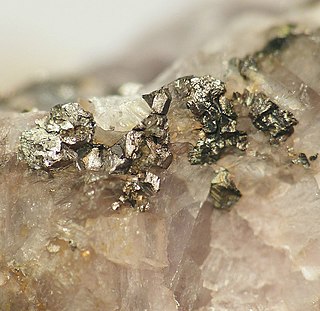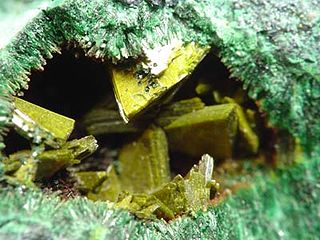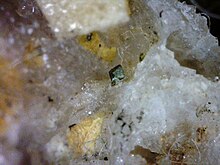
Ullmannite or Nickel glance is a nickel antimony sulfide mineral with formula: NiSbS. Considerable substitution occurs with cobalt and iron in the nickel site along with bismuth and arsenic in the antimony site. A solid solution series exists with the high cobalt willyamite.

Cohenite is a naturally occurring iron carbide mineral with the chemical structure (Fe, Ni, Co)3C. This forms a hard, shiny, silver mineral which was named by E. Weinschenk in 1889 after the German mineralogist Emil Cohen, who first described and analysed material from the Magura meteorite found near Slanica, Žilina Region, Slovakia. Cohenite is found in rod-like crystals in iron meteorites.

Rammelsbergite is a nickel arsenide mineral with formula NiAs2. It forms metallic silvery to tin white to reddish orthorhombic prismatic crystals, and is usually massive in form. It has a Mohs hardness of 5.5 and a specific gravity of 7.1.

Greigite is an iron sulfide mineral with the chemical formula Fe2+Fe3+2S4. It is the sulfur equivalent of the iron oxide magnetite (Fe3O4). It was first described in 1964 for an occurrence in San Bernardino County, California, and named after the mineralogist and physical chemist Joseph W. Greig (1895–1977).

Breithauptite is a nickel antimonide mineral with the simple formula NiSb. Breithauptite is a metallic opaque copper-red mineral crystallizing in the hexagonal - dihexagonal dipyramidal crystal system. It is typically massive to reniform in habit, but is observed as tabular crystals. It has a Mohs hardness of 3.5 to 4 and a specific gravity of 8.23.

Heazlewoodite, Ni3S2, is a rare sulfur-poor nickel sulfide mineral found in serpentinitized dunite. It occurs as disseminations and masses of opaque, metallic light bronze to brassy yellow grains which crystallize in the trigonal crystal system. It has a hardness of 4, a specific gravity of 5.82. Heazlewoodite was first described in 1896 from Heazlewood, Tasmania, Australia.

Talnakhite is a mineral of chalcopyrite group with formula: Cu9(Fe, Ni)8S16. It was named after the Talnakh ore deposit, near Norilsk in Western Siberia, Russia where it was discovered as reported in 1963 by I. Budko and E. Kulagov. It was officially named "talnakhite" in 1968. Despite the initial announcement it turned out to be not a face centered high-temperature polymorph of chalcopyrite, but to have composition Cu18(Fe, Ni)18S32. At 80 °C (176 °F) to 100 °C (212 °F) it decomposes to tetragonal cubanite plus bornite.

Cattierite (CoS2) is a cobalt sulfide mineral found in the Democratic Republic of Congo. It was discovered together with the nickel sulfide vaesite by Johannes F. Vaes, a Belgian mineralogist and named after Felicien Cattier, who was chairman of the board of the Union Minière du Haut-Katanga.
Allabogdanite is a very rare phosphide mineral with the chemical formula (Fe,Ni)2P, found in 1994 in a meteorite. It was described for an occurrence in the Onello meteorite in the Onello River basin, Sakha Republic; Yakutia, Russia; associated with taenite, schreibersite, kamacite, graphite and awaruite. It was named for Russian geologist Alla Bogdanova.
Jolliffeite is a rare selenide mineral with formula NiAsSe or (Ni,Co)AsSe. It is the selenium analogue of the sulfide mineral gersdorffite, NiAsS, with a common impurity of cobalt, CoAsSe. It is named for its discoverer, Alfred Jolliffe, (1907–1988), a Canadian geologist of Queen's University, Kingston, Ontario.

Marthozite is an orthorhombic mineral that has a general formula of Cu(UO2)3(SeO3)3(OH)2·7H2O. It was named after Belgian mineralogist Aimé Marthoz (1894–1962), former Director-general of the Union Minière du Haut Katanga (UMHK).

Sinoite is rare mineral with the chemical formula Si2N2O. It was first found in 1905 in chondrite meteorites and identified as a distinct mineral in 1965. Sinoite crystallizes upon meteorite impact as grains smaller than 0.2 mm surrounded by Fe-Ni alloys and the mineral enstatite. It is named after its SiNO composition and can be prepared in the laboratory as a silicon oxynitride ceramic.

Billietite is an uncommon mineral of uranium that contains barium. It has the chemical formula: Ba(UO2)6O4(OH)6•8H2O. It usually occurs as clear yellow orthorhombic crystals. Billietite is named after Valere Louis Billiet (1903–1945), Belgian crystallographer at the University of Ghent, Ghent, Belgium.

Djerfisherite is an alkali copper–iron sulfide mineral and a member of the djerfisherite group.
The pyrite group of minerals is a set of cubic crystal system minerals with diploidal structure. Each metallic element is bonded to six "dumbbell" pairs of non-metallic elements and each "dumbbell" pair is bonded to six metal atoms.
Owensite is a mineral discovered in the Wellgreen Cu-Ni-Pt-Pd deposit, Yukon, with the formula (Ba, Pb)6(Cu, Fe, Ni)25S27. The mineral is related to djerfisherite, but lacks the Cl and monovalent metals found in the latter.
Dr. Paul F. Kerr, was a Professor of Mineralogy at Columbia University. During the second World War, he was tasked with locating and procuring supplies of uranium for the Manhattan Project. Kerr had an academic interest in the geology of tungsten, uranium and clay minerals. He pioneered the use of X-rays in the process of mineral identification and is considered to be one of the fathers of applied mineralogy. At Columbia University he was instrumental in the founding of the Lamont–Doherty Earth Observatory.
Johannes Franciscus Vaes (1902–1978) was a Belgian mineralogist and geologist associated with the Union Minière du Haut-Katanga, in Belgian Congo, now the Democratic Republic of the Congo.












